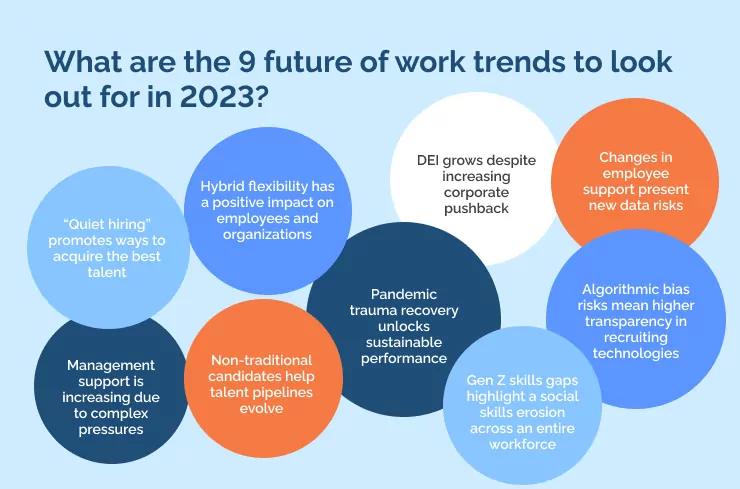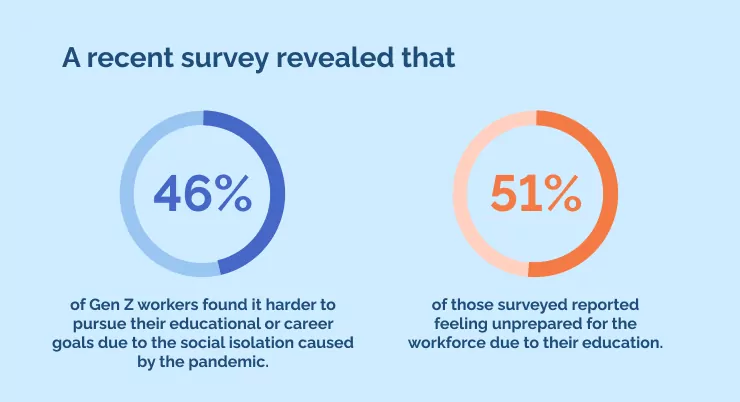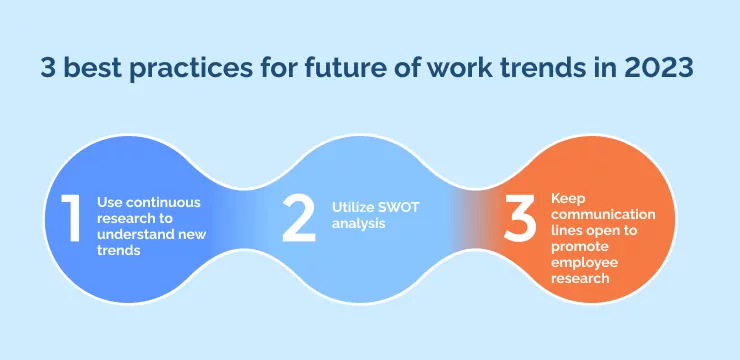
What will the future of work look like?
Will AI robots take over or help organizations provide the best services imaginable? Will VR create an immersive, virtual learning environment that pushes employee engagement to new heights or negatively impact communication and basic skills?
Nobody knows which trends will become new standards in the workplace, but you must attempt to predict the most successful trends to gain an edge over competitors.
Some trends are more accessible to predict than others, like remote work, with one study showing that 20 to 25 percent of workforces in advanced economies can work from home from three to five days a week—this is four to five times more remote work than pre-COVID-19.
It is essential to use previous trends to predict the likelihood of others to help you imagine how the future of work will look in the coming years.
To help you understand the significance of predicting the future of work trends in 2023, we will explore the following topics:
- What are future of work trends?
- Why are future of work trends significant?
- What are the future of work trends to look out for in 2023?
- What are the limitations of future work trends in 2023?
- Best practices for digital work trends in 2023
What are future of work trends?
Future of work trends are the technologies and practices that will impact how the workplace, business processes, and workforce will operate. Considering these emerging trends is essential to stay ahead of competitors and invest in the right technologies to secure your future.
Why are future of work trends significant?
To understand the significance of future work trends, we must only look to the Covid-19 pandemic and the increased popularity of hybrid and remote work, which employees expect as standard today.
Nobody could have predicted such a globally-impactful event, yet the consequences led to permanent changes that affected the trends now visible in every workplace.
Considering the number of organizations that closed due to the pandemic shows how the willingness, culture, and agility to cope with trends can lead to success or failure.
Following trends can help ensure your organization becomes agile, as it operates at its best to allow it to pivot and prepare for the worst quickly.
What are the 9 future of work trends to look out for in 2023?

Look out for these future work trends in 2023 to ensure you invest in the best technologies to help you compete in the marketplace.
1. “Quiet hiring” promotes ways to acquire the best talent
Do you remember LinkedIn’s “quiet quitting” trend in the second half of 2022?
It was one of many key trends and involved many employees avoiding going beyond their job requirements and doing the bare minimum in response to a lack of organizational focus on excellent employee experience.
This action resulted in the organizations keeping employees but losing their skills and abilities. In 2023, smart HR leaders will use “quiet hiring” to gain new skills and abilities without hiring more full-time employees.
There are a few key ways in which this will present itself:
- Companies will prioritize internal talent mobility to ensure our employees can tackle the most critical tasks without adding more staff.
- Opportunities will emerge for current employees to improve their skills and knowledge while also meeting the organization’s changing needs.
- One way to bring in talent as needed is to explore other methods besides hiring full-time employees, such as using alumni networks and gig workers.
These are the ways you can invert a trend to your benefit as you follow trends of the workforce to listen to their changing needs and meet these expectations by changing your organizational offerings to improve employee retention.
2. Hybrid flexibility has a positive impact on employees and organizations
Office-based employees transition to a more permanent era of the hybrid working model, it is crucial to ensure fair flexibility for frontline workers such as those in manufacturing and healthcare.
One survey shows that 58% of organizations with frontline workers have tried improving their employees’ experience in the past year and around one-third of those who have not yet invested in this area plan to do so within the next 12 months.
Providing flexibility is becoming increasingly important for organizations looking to attract frontline workers as this is part of employee expectations following the Covid-19 pandemic. The top factors that attract frontline workers include flexibility in their job roles include:
- Stability for the work schedule.
- Ability to control work schedule and work remotely.
- Paid leave, including paternity and menstrual leave.
In addition to flexible schedules, frontline workers have shown interest in other types of flexibility, such as their tasks, coworkers, and the number of hours they work to improve employee health.
3. Management support is increasing due to complex pressures
Managers are struggling to meet the demands of the current working environment. They often feel pressured to implement the company’s hybrid work strategy and provide employees with purpose, flexibility, and career growth.
Managing people is a skill that requires practice, and the challenges posed by remote work and changing employee needs and expectations have worsened the impact of inadequate management.
More companies are beginning to set guidelines for managers to clarify how they should manage their time and adjust their duties as needed to prioritize tasks to improve their mental and physical health.
4. Non-traditional candidates help talent pipelines evolve
Business leaders from many organizations have been discussing the importance of diversifying their talent management pipelines for a long time, and now it’s time to take action.
Two main trends have emerged:
- More candidates are applying for jobs in fields that differ from their current area of expertise, indicating a trend of nonlinear career trajectories. This phenomenon is likely to increase as more office workers become freelancers.
- Sourcing methods and candidate pools are no longer sufficient for organizations to fulfill their talent needs. Hiring managers are now less focused on industry experience and technical skills than they used to be.
To fill essential positions in 2023, organizations must prioritize evaluating candidates based on their capacity to succeed rather than solely on their credentials and experience. There is a pressing need to reconsider outdated notions about qualifications.
5. Pandemic trauma recovery unlocks sustainable performance
As a result of recent societal, economic, and political turbulence, many individuals, including current and new employees, are struggling with mental health issues.
This situation may lead to decreased productivity and performance, increased angry outbursts, sudden quitting, workplace conflict, and underperformance.
According to recent findings, 82% of employees believe that their organizations must recognize them as complete individuals, not just employees.

In the following year, top-performing organizations will focus on implementing this principle with the following strategies:
- Proactive rest helps employees maintain their emotional resilience and performance and promote overall well-being and work-life balance, like the option to take time off before busy periods and providing designated wellness time.
- Discussion opportunities to resolve challenges and complex topics free of judgment or consequences.
- Trauma counselors offer on-site counseling and train and coach managers on how to tackle workplace conflict productively and have challenging team member conversations.
6. DEI grows despite increasing corporate pushback
Certain employees are demonstrating opposition as more companies work to strengthen their diversity, equity, and inclusion (DEI) initiatives.
Attitudes towards diversity, equity, and inclusion (DEI) become more intense via political and ideological views that consider it either social manipulation or discrimination against historically favored groups.
When employees push back against DEI programs, it undermines the efforts to empower marginalized communities. This pushback can be either apparent or hidden or intentional or unintentional.
Ignoring employee pushback can lead to decreased engagement and inclusion, eventually resulting in people departing the organization. In 2023, smart leaders will address employee opposition early on to prevent it from turning into more disruptive resistance.
7. Changes in employee support present new data risks
Organizations are adopting new technologies such as AI assistants and wearables to gather information on employees’ health, family status, living conditions, mental health, and sleep patterns. The goal is to be better equipped to meet the employees’ needs.
The fast expansion of technological capabilities is causing a potential privacy crisis, as leaders may not fully understand or control these developments.
Organizations becoming more people-focused may inadvertently violate boundaries by accessing and using profoundly personal and private information beyond just employee data.
in 2023, employers must prioritize being transparent about how they collect, use, and store employee data and give employees the option to opt out of any practices they find objectionable.
Creating a bill of rights for employee data that prioritizes healthy boundaries and well-being.
8. Algorithmic bias risks mean higher transparency in recruiting technologies
Organizations and vendors using AI and machine learning for hire will need to stay ahead of upcoming privacy regulations set by the government.
Organizations using AI for recruiting should be more explicit about their usage and publicize their data audits. They should also allow employees and candidates to opt out of AI-based processes to ensure ethical practices regarding fairness, diversity, inclusion, and data privacy.
9. Gen Z skills gaps highlight a social skills erosion across an entire workforce
A recent survey revealed that 46% of Gen Z workers found it harder to pursue their educational or career goals due to the social isolation caused by the pandemic.

Additionally, 51% of those surveyed reported feeling unprepared for the workforce due to their education.
Gen Z may have had limited opportunities to develop critical soft skills such as negotiation, public speaking, networking, and the ability to work long hours with social awareness and endurance due to the lack of in-person work experience.
During the pandemic, burnout, exhaustion, and career insecurity have increased and negatively affected job performance. Organizations should redefine professionalism for their entire workforce to overcome this challenge.
3 best practices for future of work trends in 2023

Follow these best practices to ensure you optimize your research and implementation of future work trends in 2023.
Use continuous research to understand new trends
Investing in a new trend can involve millions of dollars and should be taken with significant consideration and deep research.
Do your homework before making decisions to invest and involve as many different departments and levels as possible to ensure investing in a new trend is precisely what you need right now.
Utilize SWOT analysis
The best way to provide value to your organization with the latest future work trends involves several factors, all of which SWOT (Strengths, Weaknesses, Opportunities, and Threats) analysis covers as it enables personalized learning approaches as you define the scope of each trend for your organization.
This method will help your organization develop a clear vision for future actions as you ensure investment provides ROI.
Keep communication lines open to promote employee research
Communicating updates to the new future of work trend initiatives with as many staff as possible creates motivation and a sense of agency as they feel included.
Doing so makes it more likely that staff may research new trends and contribute their suggestions, ensuring varied and regular opportunities to offer their views.
Use a DAP to support future trends and ensure stability
As the world looks to the future of work and the development of new technologies, it’s essential to recognize and consider how trends in 2023 will shape the job market.
We must know that dramatic changes are happening now, and even more large shifts will occur in the next few years.
Businesses must stay informed about current and emerging trends to remain competitive and viable through this transition.
We can ensure long-term stability for tomorrow’s global workforce with thoughtful planning and preparedness today. And when you decide what trend to invest in, a DAP can support staff to learn how to utilize it with its in-app guidance and personalized learning.
Look towards the latest future work trends to keep your organization successful.
Tristan Ovington
Tristan Ovington is a professional senior writer and journalist, specializing in providing expert insights on various topics such as digital adoption, digital transformation, change management, and Cloud apps. He delivers his knowledge through accessible online content that is data-driven and presented in a friendly tone, making it easy for readers to understand and implement.



